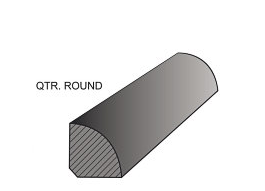In the industry, it is called by different names. I can only imagine how confusing it must be for customers when it comes to understanding industry lingo. I like transition. Why? Because you're either transitioning between one product or another, one room or another or one surface or another.
Why are transitions important?
If there is one thing that is likely to go wrong with a hardwood installation it is almost always related to the transitions. Either they were omitted completely (this is why using a business that's been in the industry and focuses on flooring is so important), the wrong transition type was recommended, they didn't match the floor, they were on back order...the list goes on. If you're one of those people who can't stand a project that gets 90% complete and then grinds to a halt, this knowledge is for you.
Being proactive is key. Ask about transitions. Ask about possible back orders. Explore stain-to-match options, (sometimes unfinished transitions professionally stained to match your floor look better than the manufacturer's transitions...and cost less, too) ask whether the flooring will go under the baseboards (#4) or will require quarter round (#5) or shoe molding (#6). If you don't know, ask.
There are six bread and butter transitions for most hardwood floors.
#1 REDUCER
First is the reducer. There are numerous types of reducers but this is the 101 class. Proceed down the hall for the advanced class. The reducer simply reduces the height of the hardwood floor down to a floor of different a different height. For example, if you had a doorway with hardwood in one room and vinyl in another, you could put a reducer up against the hardwood and over the vinyl.
 |
| Reducer |
#2 T-Molding
Second is the T-molding. Named after its shape, the T-molding joins two floors of equal height.
Below is a drawing of a T-molding seated in a hardwood floor.
 |
| T-molding |
Third is a stairnose. A stairnose is typically used at the edge of a step to round off the edge.
Below are two installed stairnose. Notice the width of the stairnose is no greater than the flooring boards behind it.
#4 Baseboard
Fourth is the baseboard. The baseboard covers the raw edges of the hardwood where it meets the walls. Many times, especially in homes that are being remodeled, the baseboard is already on the walls and the hardwood is unable to be installed beneath.
 |
| Baseboard |
Below is a photo of baseboard installed directly over the raw edges of the hardwood flooring.
#5 Quarter Round
#6 Shoe Molding
Numbers five and six accompany the baseboard when the raw edges are unable to be installed beneath. They are the quarter round and shoe molding.
 |
| shoe molding |
As you can see, there is a difference in shape and size. Using one versus the other depends on the gap that requires covering (the raw edges of the hardwood) as well as the desired look. Below is a shoe molding installed over vinyl tile against a typical baseboard.
All other transitions are simply variations of the transitions described above.
 |
| Baseboard over hardwood |
 |
| Wood to carpet with a reducer |
 |
| Tile to wood where a turned board serves as a transition |
 |
| Wood against a fireplace (details below) |
Next time: Pets for Patriots; What Bob Wagner's is doing to help create happy, loving homes for adult shelter pets and military personnel; whiskers and wet noses galore.
A special thanks to our vendors, Armstrong, Mullican Flooring and Tague lumber for providing some of the images.












